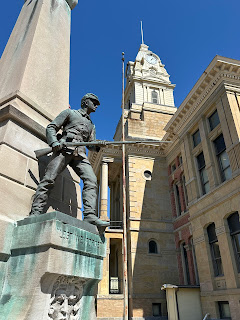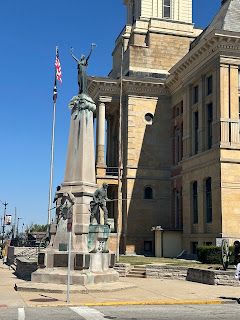I enjoy listening to people share their stories. Which is why I
enjoyed being a Hospice Chaplain. I learned to allow people to tell their own
story. However, I could only hear their story once I experienced it in their
voice, including letting them tell their story in their own way. Over the last
couple of years on the road, I have become acutely aware of how deaf I had
become to the stories of Native Americans, African Americans, Hispanics, LGBTQ,
and others who came from different backgrounds and experiences. For example, many
Native Americans tell stories with symbols inscribed into or onto rocks or in
pictures painted on skins or woven into blankets. Those who do not speak this pictographic
language see them as primitives. Therefore, they cannot "read" the
story and rely on conjecture grounded in their own stories and prejudices. If a
“native speaker” translates for us, we hear it as propaganda and dismiss it as
self-serving nonsense. Lest we get too tied up in ourselves, even people with a
European background tell stories in their own way. They differ by degree, if
not by the medium of communication. I need only cite Cincinnati Chili for an
example of how another group of people experience a common word in unique ways.
Hearing other’s stories is hard. It requires a great deal of respect for others
and their differences. Thus, respect is a key value for all travelers. This
week, I have worked hard to listen respectfully.
Our week started on Friday as we prepared to leave Lynnville and
Southern Indiana. This was a short stop, a mere respite for the drive between
Louisville and Indianapolis, but it turned out to be a gem. Except for a trip
to Lincoln’s Boyhood home, we spent most of our time relaxing and enjoying the
trails and scenery at the park. It was a nice break from our touristy lifestyle
of late. (Check out last week’s blog.)
As Saturday dawned, it was time to head North. We packed up Koko
and Nakai and began our drive through Central Indiana. Crawfordsville, IN is a
small town that is NW of Indianapolis. I
grew up in towns about this size and felt right at home. We knew we wanted to
go into Indy, but as I looked around the area, I saw that Indy would not be our
primary focus during this stay. I found it very easy It was to listen to
Crawfordsville’s stories. In many ways, it spoke the same “language” as my
hometown back in Texas.
 On Sunday, we started our day with a hot dog and a visit with the
people who drive the Midwest Oscar Meyer Weinermobile. They had made a stop at
our KOA and the Camp provided a free Hot Dog. The young couple who drove the
Hot Dog were very personable and talked about their life on the road. They
covered most of the Midwest and had visited many of the places we had been.
They were also headed south. They spoke of how much they enjoyed visiting
people in the campground since most of their stops were at supermarkets. After
meeting them, I thought that that would be a great job for someone fresh out of
college. Imagine traveling to the US and meeting people from all over. That is
where the real education happens!
On Sunday, we started our day with a hot dog and a visit with the
people who drive the Midwest Oscar Meyer Weinermobile. They had made a stop at
our KOA and the Camp provided a free Hot Dog. The young couple who drove the
Hot Dog were very personable and talked about their life on the road. They
covered most of the Midwest and had visited many of the places we had been.
They were also headed south. They spoke of how much they enjoyed visiting
people in the campground since most of their stops were at supermarkets. After
meeting them, I thought that that would be a great job for someone fresh out of
college. Imagine traveling to the US and meeting people from all over. That is
where the real education happens!








 |
Bosque Redondo was an infamous internment camp in New Mexico.
|
 |
The Canal
|
 |
Asians are also part of the history of the West.
|
 |
Young Native people are also telling their story!
|
Monday became a Chill Day. After
my weekly Zoom with friends, I set up the smoker, pulled out my chair, and
enjoyed a day reading and napping while the chicken smoked away. It was time to
listen to the history of the Native People as one historian shares their story in
Native Nations: A Millenium in North America, by Katheleen DuVal. Coincidentally,
the stories she shares happened in the places we have been visiting for the
last month. The reading enhanced my empathetic listening to all that we have
been experiencing over the last several months. Yep, travel does teach “old
dogs” new tricks!

As Tuesday rolled around, we packed our hiking gear for a Turkey
Run State Park trip. This is a beautiful state park along Sugar Creek. We
walked a trail that included Boulder Canyon. This moderate hike could have been
treacherous, but the rock was not slick. We walked over boulders and narrow
ledges as well as through mud. But the sights were extraordinary. The images do
not do them justice. After a picnic lunch, we returned to Nakai and searched
for old Covered Bridges.
 |
The Suspension Bridge to the trails
|
 |
Sugar Creek
|
 |
The woodlands
|
 |
Into the canyon on the first of many stairs.
|
 |
Yep, that's the trail.
|
 |
That is the trail, also!
|
 |
Minerals seeping out of the rock.
|
 |
Emerging from the Canyon
|
 |
Across the Suspension Bridge
|
 |
Cox Ford Bridge
|
Parke County, Indiana, is well-known for the 20+ covered
bridges. Most no longer handle traffic, but a few are still in service. The covered
bridges allowed me to see this land through the eyes of the people who have lived
here. The bridges are covered in order to protect the wood and roadway from the
elements. The three bridges spanned Sugar Creek and relied on internal arches
to support the weight. They reflect a high degree of engineering for the people
who adapted to this place and time. As such, these bridges speak to the lives
of people who traveled to market in horse-drawn wagons and saw the need to work
together to improve the lives of everyone. The fact that they are still
preserved and protected offers insight into how proud these people are of their
continuing life here at the prairie's edge. |
Spanning the Creek
|
 |
The Narrows Bridge
|
 |
Deer's Mill Bridge
|
 |
The Internal Supports
|
Our last full day in Crawfordsville was spent exploring the town
itself. Walking downtown, we saw the Montgomery County Courthouse complete with war memorials.
There is also a garden study built by Lew Wallace, a Civil War hero and author
of Ben Hur. He was also the son-in-law of the town's founder and part of the
elite. In addition, we saw the last rotary jail that still has a working
mechanism and the county museum in the old Carnegie Library Building.

 |
The Rotary Jail Museum
|
The Rotary jail was one of five built across the Midwest in the
late 19th century. The cells were built on a 2-3 stories high
carousel. Each level had a single opening for 6 wedge-shaped cells. The
platform would rotate to a single door to allow guards and inmates access into
and out of the cells. The rotation was operated by a hand crank. It saved on
personnel and was intended to save the county money. Unfortunately, if someone
held onto the bars while the platform was turning, they would lose fingers, or worse.
This jail had narrow bars after other designs allowed inmates to place their
heads through the bars, which led to unfortunate consequences. Further, there
was no way to evacuate all the cells quickly in an emergency. The rotating
function was disabled, and doors were cut into each cell before the jail was
closed in the Mid-20th century. This jail is one of three that still
survive.
 |
The only cell with a view.
|
 |
Women and Children's Cell
|
 |
| Solitary |
 |
The Design
|
 |
Booking Desk
|
 |
Barber's Chair
|
 |
Guard's Desk
|
The Carnegie Museum is in a beautiful old Library built by the
Carnegie Foundation in the 1800s. The Curator explained that this Museum is for
locals to come and "Remember when…" However, the Museum shared the
story of Crawfordsville, especially in the eyes of contemporary residents. I
always enjoy these local museums. They help me understand the people and places
that have offered us hospitality along the road. Thank you, Crawfordsville!
 |
| Switchboard |
 |
An Addressograph like the one I used at the Newspaper.
|
 |
Model of the Deer's Mill Covered Bridge
|
On Thursday, we left Indiana and drove across the middle of
Illinois. The picture could have been taken anywhere along the
two-and-a-half-hour drive. The soybeans and corn stretched as far as the eye
could see. The occasional tree line would appear with the highest leaves
starting to suggest the change of season. I cannot tell you how relieved I was
when we encountered hills and more trees in the last few miles. When we arrived
at our campsite in Rochester, just outside Springfield, I was overjoyed to see
tall trees and shade!
Our first full day in Springfield took us to three iconic Abraham
Lincoln sites. Springfield was his home for 24 years. Lincoln settled in
Springfield after leaving his boyhood home in Indiana. He spent a few years in
New Salem, just north of Springfield. Lincoln arrived with two saddlebags that
contained his worldly possessions and started his new job as a junior partner
at a law firm. He met and married Mary Todd, who lived in the posh part of
town. They raised three of their four children in the house on 8th
Street and buried one of them. He had fully intended to return to Springfield
after his second term in the White House but never returned. Mary never
returned either because of the memories that the town held for her. Yet, as one
travels about town, I could feel his presence everywhere!


 |
Model of home when they bought it for $1,500.
|
 |
Model of home after first renovation.
|
 |
Final Renovation
|
 |
S 8th Street
|
 |
The Lincoln Home
|
 |
Formal Parlour
|
 |
Dining Room
|
 |
Mary's Room
|
 |
Abe's Toiletry Stand
|
 |
Abe's Writing Desk
|
 |
Abe's wardrobe
|
 |
Guest Bedroom
|
 |
Family Parlour
|
 |
Family Parlous. Abe did not fit in any of the chairs. He usually sat on the floor.
|
 |
Where Abe took off his boots on entering the house.
|
 |
A Neighbor's Dray Wagon.
|
 |
Neighborhood House
|
 |
Replica of Campaign Wagon
|
 |
Wooden Sidewalks
|
 |
Back of the Lincoln Home
|
 |
| Kitchen |
 |
Back Stairs
|
 |
Robert Todd's Bedroom
|
I mentioned that we walked the same route that Lincoln would
have walked each day when he went to his law office. We ate lunch across the
Street from the Lincoln and Herndon – Law Offices building. We then walked two
blocks past the Old Indiana Statehouse, where Lincoln served several terms as a
representative, and arrived at the Lincoln Presidential Museum and Library. We
toured the Museum that told the story of the Lincolns in wonderful multimedia
films, life size dioramas, and a few artifacts. It was an enjoyable few hours
hearing the familiar and unfamiliar stories of the Lincoln legacy. |
First Presbyterian Church
|
 |
Law Office Building
|
 |
The Old Statehouse
|
 |
Abe welcomes us to his cabin.
|
 |
Cabin Interior
|
 |
Abe affected by watching a Slavery Auction.
|
 |
he Tried Running a Store in New Salem.
|
 |
Abe and Mary a'courting.
|
 |
Abe and Douglas debating Slavery made him a household name.
|
 |
Abe's Parenting style was very laid back.
|
 |
The Younger Boys entertaining the,selves at Abe's Law Office
|
 |
Mary and her maid.
|
 |
During the death of their first child.
|
 |
A Mother's Sorrow
|
 |
Abe's Cabinet debating the Emancipation Proclamation.
|
 |
Pondering Releasing the Proclamaion
|
 |
{hotos showing how his life in the White House aged him.
|
 |
A cast made 6 weeks before he died. It looks like a death mask.
|
 |
Ford's Theater
|
 |
Moments before the shot rang out.
|
 |
Lying in State in House of Representatives in DC.
|
 |
The First Family
|
 |
Frequent visitors to the White House, Frederick Douglas and Sojourner Truth
|
 |
A lonely man
|
 |
A Home-grown Stateman
|
 |
The Presidential Library
|
 |
Stautue of the Lincoln Family shopping in the Old Springfield.
|


 |
The Great Emancipator
|
 |
Abe heading out on his own.
|
 |
Heading to Springfield with all his worldly possessions.
|
 |
The Country Lawyer
|
 |
The Great Debater
|
 |
At Rest
|
 |
The Noble Lincoln
|
 |
Tthe Compassionate Lincoln
|
 |
The Man of Intergity.
|
 |
A Man of Humility.
|
 |
The Rotunda
|
 |
"He belongs to the ages!"
|
This week, I am grateful for the gift of empathy that has allowed
me to walk with so many people in Indiana and Illinois, from those who have
lived on this land for over 10,000 years to others who, like me, were
immigrants to a new home. I have tried my best to hear their voices as they
told of their experiences in this place. Empathy is only possible when we
choose to be respectful of all people and offer them the attention and
forbearance required to discern their voice among all the others screaming in our
ears. To travel well means to extend this respect to all people, living or dead,
listening for their voices, which is more than just hearing or reading
words. It means listening with empathy and insight and seeking to understand,
not critique. That respect has helped me add all these voices to the
conversation with those who continue to help me understand life and the world
we all share. For all these voices, I remain eternally grateful.
Travel well, my friends.
Bob
 |
Filling in the last state for this trip. Four more to go to finish the map.
|






































































































































































































































































